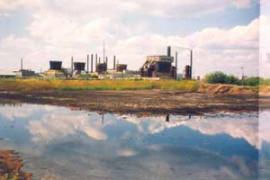Dzerzinsk, Russia
- Potentially Affected People: 300,000
- Type of Pollutants: Chemicals and toxic byproducts, including Sarin, VX gas, etc. Also lead, phenols.
- Source of Pollution: Cold War-era chemical weapons manufacturing
The Problem
Until the end of the Cold War, Dzerzhinsk was among Russia's principal production sites of chemical weapons. Today, Dzerzhinsk is still a significant center of Russian chemical manufacturing. The city was also home to a leaded gasoline factory that produced TEL, a potent toxin. However, little attention was paid to the impacts of all this production. According to figures from Dzerzhinsk's environmental agency almost 300,000 tons of chemical waste were improperly disposed between 1930 and 1998. In this waste, around 190 identified chemicals have been released into the groundwater. In places, the chemicals have turned the water into a white sludge containing dioxins and high levels of phenol - an industrial chemical that can lead to acute poisoning and death. These levels are reportedly 17 million times the safe limit. The Guinness Book of World Records has named Dzerzhinsk the most chemically polluted city in the world.
Because a number of industries are no longer in operation, the local groundwater has risen, along with the water level in the canal. This rise in the water level threatens to release massive amounts of arsenic, mercury, lead and dioxins into the Oka river basin, a source of drinking water for the nearby city of Nizhny Novgorod. Drinking water supplies in Nizhny Novgorod City and adjoining villages such as Gavrilovka and Pyra are heavily laced with contamination.
Health Impacts
A quarter of the city's 300,000 residents are still employed in factories that produce toxic chemicals. According to a 2003 BBC report it is the young who are most vulnerable. In the local cemetery, there are a shocking number of graves of people below the age of 40. In 2003, the death rate was reported to exceed the birth rate by 260%. The city's annual death rate, 17 per 1,000, is higher than Russia's national average of 14 per 1,000. In the city of 300,000, that translates to about 900 extra deaths annually. The average life expectancy is reported to be 42 years for men and 47 for women.
Status of Clean-Up Activity
A number of isolated efforts have been undertaken to deal with individual plants and sources of contamination but there has been no concerted effort to deal with the huge problems in a systematic way. A local NGO (DRONT), supported by Blacksmith and in cooperation with the Nizhniy Novgorod municipal government, has brought together a steering committee to work on the design of a large-scale remediation and pollution mitigation plan for the entire affected area. Following support for a baseline study in 2004, Blacksmith Institute, in cooperation with the local government, funded the installation of water treatment systems in two villages where drinking water supplies were heavily contaminated - in Pyra and Gavirolvka. However, these are very small-scale initiatives relative to the efforts needed to remediate this devastatingly polluted area.
Local officials assert that no ecological disaster is present. However, it is likely that their tests only monitored pollution levels in the atmosphere and perhaps in surface waters and not the extent of legacy contamination. The health of local residents is still threatened by legacy pollution issues.
Resources
Dzerzhinsk Chemical Plant Workers Call for Better Pensions: FBIS-TAC-97-119: 29 Apr 1997
Russian Chemical Weapons Sites Undergo Foreign Inspection: FBIS-TAC-98-068: 9 Mar 1998&
M R. Edelstein. "Empowering Russian And American NGOs To Address Issues Of Future Sustainability" Final Project Report. Ramapo College of New Jersey (2005)
http://phobos.ramapo.edu/facassem/edelsteinempoweringngos.html
"Dzerzhinksk" Global Security Organization.
http://www.globalsecurity.org/wmd/world/russia/dzerzhinsk_cbw.htm
Tim Samuals, "Russia's Deadly Factories". BBC News. March 7, 2003.
http://news.bbc.co.uk/1/hi/programmes/correspondent/2821835.stm




